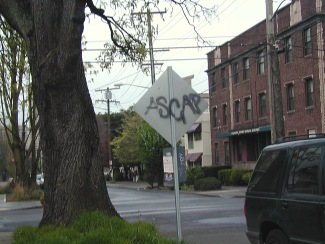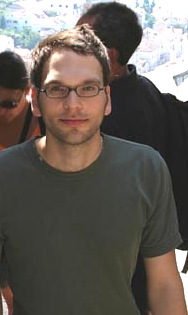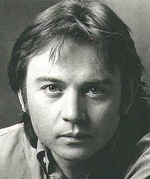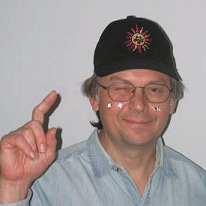A million wet puppy kisses to Alex Ross for the Sequenza21 shout out in this week’s New Yorker. We love you, too.
Many apologies for going silent for several weeks (I just KNOW you’ve been losing sleep without this column). Without giving excuses, I’ll move right along to three recordings you may not hear about anywhere else:
 Mark Zuckerman
Mark Zuckerman
New Music for Strings
Seattle Sinfornia; Joel Eric Sueben
Momenta Quartet
(MSR Classics 1223)
Much of Mark Zuckerman’s music is infused with dance figures and folk melodic ideas, and makes us of titles in Hebrew and stories from the Old Testament. One such work, Out of the Wilderness, is a five-movement “symphony” based on a passacaglia and is “a metaphor for the continuing trek of eth Jewish people…” The Seattle Sinfonia performs well, but I must complain about the editing in track 5. A very poor splice is clearly evident at about 1:08, where the music “skips.” This isn’t something one should expect from a commercial release.
Two short, tonally centered works, Shpatsir (Yiddish for “stroll”) and Theme Song, are light interludes between the heavier fare.
The final work, a string quartet, provides for interesting listening, if the sound editing, again, weren’t so obvious. The fake reverb and echo is so apparent in the first few seconds, you can almost see Garage Band. This is nothing against Mark Zuckerman’s work, but I am unhappy with MSR Classics’ product.
 Norman Dello Joio
Norman Dello Joio
Two Concert Etudes
Music for Piano Trio “The March of Folly”
Sonata for Piano
Garrick Ohlsson
Ani Kavafian, Carter Brey, and Jeremy Denk
(Bridge 9220)
There are occasions when twenty-three minutes of music comes together in the last three minutes, as though to say “The moral of the story is…” Justin Dello Joio’s Piano Trio “The March of Folly” (inspired by Barbara Tuchman’s book of the same name) achieves such a climax (or anti-climax) in its Epilogue after twenty minutes of angst and anger. It is an optimistic finale, but one that doesn’t overshadow the message of its predecessor movements. Ani Kavafian (violin), Carter Brey (cello) and Jeremy Denk (piano) offer a compelling and powerful performance.
Garrick Ohlsson frames the trio with performances of two solo piano works, both tremendously difficult and complex. The music is often angular, interspersed with sweeping romantic gestures: One moment in the sonata is almost Lisztian.

New Music for Electronic and Recorded Media
Women in Electronic Music 1977
(New World Records 80653-2)
I like to read magazines from back to front. So, I listened to this CD from the last track to the first, causing a kind of aural time travel through electronic music.
The last two works by Laurie Anderson (b. 1947) are from 1977, and are short portraits of people: A New York artist (New York Social Life) and an art museum guard (Time to Go). In New York Social Life, Laurie Anderson plays two characters, one “live” and the other prerecorded on a telephone, accompanied by Scott Johnson on a tambura. This pre-Sex and the City diary-entry is humorous, and would be fun to see live. Time to Go depicts a museum guard telling people, well, “It’s time to go.” Once again, Laurie Anderson, singing and playing the violin, is accompanied by Scott Johnson on guitar and organ.
Ruth Anderson’s (b. 1928) Points from 1973-74, is a static sound journey using sine tones. Megan Roberts (b. 1952) was next (moving backwards) with I Could Sit Here All Day (1976) for drums, electronics, and screaming voices. Insane-asylum sound environment meets hypnotic drumming pattern.
Appalachian Grove I (1974) was Laurie Spigel’s (b. 1945) first composition of computer-generated tape music after studying the GROOVE programming system. Spiegel’s love for the banjo, fiddle playing and the plectra are explored through electronic sounds that evoke modes and gestures found in Appalachian music.
Pauline Oliveros (b. 1932) makes an appearance with Bye Bye Butterfly from 1964. It was created at the Tape Music Center studio. New Zealand-born Annea Lockwood (b. 1939) created World Rhythms in 1975 from sounds found in the environment (pulsars, earthquakes, human breathing, etc). A live gong is played throughout the performance and, when performed live lasts between thirty-nine to ninety minutes. This recording offers an eight minute version.
Johanna M. Beyer (1888-1944) created one of the first pieces of electronic music in 1938 (!) and called it Music of the Spheres. The premiere performance took place in 1977, at the Cabrillo Music Festival, given by Allen Strange who realized the score for this recording. It comes from a larger work for theatre called Status Quo and represents Beyer’s feelings of injustice during her days. A friend of Percy Grainger and a student of Henry Cowell, she was and still is largely unknown today. This recording features The Electric Weasel Ensemble.
In a remarkable article in today’s Washington Post, Pearls Before Breakfast, Gene Weingarten examines what happened last Friday when, as an experiment, Joshua Bell busked in a Washington DC subway. What happens, why it happens, and the role that beauty plays in our lives are explored. I’ll let it slip that only 3 people spent any time listening and only one recognized him. A provocative and chilling experiment which explores the spiritual malaise of America more than it touches upon obvious classical/thanatological, arts education, etc. issues.
The big news out of Los Angeles this morning is that Gustavo Dudamel, the 26-year-old Venezuelan wunderkind, will replace Esa-Pekka Salonen when he leaves the LA Phil at the end of his term in 2009. Salonen plans to spend more of his time composing.
Happy Easter or Passover or whatever mystery cult holiday your side of Abraham’s futon celebrates this time of year. It’s a chilly one here in the Center of the Universe; about 30 degrees (-1) but I’m snug inside and listening to Frank Martin’s in terra pax (Chandos 9464, with Matthias Bamert and the London Philharmonic). On deck is Stravinsky’s Symphony of Psalms (Naxos 8.557504, Robert Craft with assorted forces) and George Crumb’s The River of Life and Unto the Hills, with Ann Crumb and Orchestra 2001 (Bridge 9218 A/B).
What’s on your best-for-Easter playlist?
 Spotted this morning across the street from my place here in Seattle. I hear the BMI bangers are tagging all the dumpsters south of Pike Street. Looks like a war is coming…
Spotted this morning across the street from my place here in Seattle. I hear the BMI bangers are tagging all the dumpsters south of Pike Street. Looks like a war is coming…
 “But I do believe the people who are the most immortal are the composers. The man on the street, he knows who Beethoven is, he knows who Mozart is. And I’d like to compose.”– Joshua Bell, from a CNN story on his win of the Avery Fisher Prize
“But I do believe the people who are the most immortal are the composers. The man on the street, he knows who Beethoven is, he knows who Mozart is. And I’d like to compose.”– Joshua Bell, from a CNN story on his win of the Avery Fisher Prize
April 7th, 2011: Gerald called. Says if I don’t do Tchaik in Berlin this November I can kiss my contract goodbye. Sigh. My cello sonata needs the time. I just got the draft back from Yo-Yo who has reservations about the dead butterflies. But that’s the sound I want!! He’d do it, but I can tell he’d rather not . . . And Manny still can’t get the hang of bowing piano strings. I’ve showed him ten million times, but . . . Anyway so I have to put the entire thing back under the knife. Also heard from Sony. They want to hear “exosphere” before agreeing to record. Fair enough, but you try to find twelve accordion players who are available the same afternoon for a session! Ugh. And Edgar’s in town next week and wants to have dinner at Saint Georges. I guess I can spare the money. He’s a pal, and, who knows? Maybe I can get him to commission that bass and percussion piece I’ve been thinking about . . . Oh and the rehearsal with Hillary? Disaster. Ask her to play double-stop trills, no problem. But write one measly microtone, and forget it: we spent twenty minutes on one single note, and I’m still not sure she has it. At least the fifth annual S21 concert at Carnegie was awesome. Wish those guys would show me some love . . .
For those of you who may not be familiar with it, there is a seminal document called The Cluetrain Manifesto that defines a new style of communication in an age in which everyone and everything is electronically connected. Its premise, to which I subscribe, is that the internet is fundamentally different from mass media like television because it allows lots of people to have “human to human” conversations (with all the complexity and difficulty that implies) rather than being force fed a one-sided party line or mass marketing message.
There can be negative aspects to this ubiquetous connectedness. Some people hide behind the mask of anonymity on the internet to say and do cruel and destructive things. But, in the best case scenario, the web allows us to talk to each other and–under the right conditions of respect, transparency, and honesty–to learn and even grow into a community where people can disagree without being disagreeable. I believe Sequenza21 is one of those rare communities and that makes me proud.
The first of the Manifesto’s 95 theses is this: “Markets are conversations.” In other words, if people are talking seriously about your product, or your Whitney concert, that is a positive thing from both a human and commercial point of view.
Just an old hippie (and professional marketer’s) point of view.
p.s. We need a new conversation started over on the Composer Forum page. If you don’t have a user name or password to post something let me know and I’ll fix you up.
Lots of terrific new reviews over on the CD Review page.
I listen to the fantastic Counterstream radio (see toilet seat icon) while I work and yesterday heard a terrific piece by Ezra Sims and it occurred to me that somebody ought to voluteer to write a regular column here every week or every other week called something like “Underrated,” which would focus on composers we don’t hear much about.
Kevin Gallagher, guitarist and founder of Electric Kompany, writes:
I noticed in your Jacob TV piece that there was hardly any mention of the fact that Electric Kompany is doing a world premiere of White Flag (for rock quartet and tape) based on sounds from the Iraq war starring the voices of Bill O’Reilly and George W Bush at the Whitney Museum at Altria on Friday, May 4 at 8pm.
Needless to say, I was pretty upset that they aren’t stressing this piece to the press. It’s rare enough to have a world premiere for rock quartet at the Whitney, never mind to have it tied to the biggest news story for the past 5 years.
I don’t know if the Whitney is scared of it (possible), but I want people to know what we’re about to do. It’s a good piece and we’re going to play the hell out of it. If you could please make sure people know about the premier, I would be very appreciative. Thank you for your help.
(I think I’m going to switch to mid-week from here on; people seem to like it.) Our regular listen to and look at living, breathing composers and performers that you may not know yet, but I know you should… And can, right here and now, since they’re nice enough to offer so much good listening online:
Tom Rojo Poller (b. 1978 — Germany)
 Born in Osnabrück, Poller began his composition studies in 1996 at the Hochschule für Musik Detmold, continuing with Prof. Walter Zimmermann at the Universität der Künste Berlin (UdK). After an exchange year at the Royal College of Music London in 2003, he received his diploma and returned to Berlin where he’s just finished his postgraduate work. Since 1999 he’s also been studying German Literature, Philosophy and Musicology at the Humboldt-University in Berlin. Last year, as participant of the Global-Interplay-project, he attended conferences in Accra, Ghana.
Born in Osnabrück, Poller began his composition studies in 1996 at the Hochschule für Musik Detmold, continuing with Prof. Walter Zimmermann at the Universität der Künste Berlin (UdK). After an exchange year at the Royal College of Music London in 2003, he received his diploma and returned to Berlin where he’s just finished his postgraduate work. Since 1999 he’s also been studying German Literature, Philosophy and Musicology at the Humboldt-University in Berlin. Last year, as participant of the Global-Interplay-project, he attended conferences in Accra, Ghana.
Tom is especially interested in the temporal aspect of music (including polyrhythmical/polymetrical music); music theater — or more generally, various forms of musical representation; the relation between music and language; the philosophy of music (especially music and the emotions, music and understanding). His music is deeply rooted in the western European musical tradition, but is greatly influenced by its lesser known aspects (e.g. medieval and renaissance music, rhetorical aspects of baroque music).
His website shows off all of these interests; his music page there is especially generous about providing quality listening to his already-amazing pieces (the recordings and performances are generally top-notch). This is someone to keep an eye on in the coming years.
………………….
Tristan Fuentes (b. 1951 — Mexico), Joe Holmquist (b. 1951 — US)
The official word is:
 Tristan Fuentes, born 1951 in Mexico City, is the son of a school teacher and barrister. His first ensemble experience was “Cherub Choir” as a five-year-old, and piano studies followed at age six. In the fifth grade he had the opportunity to join the class band. It was denied that he play trumpet but firmly suggested that he play drums. At age fifteen he organized his first combo and started playing professionally.
Tristan Fuentes, born 1951 in Mexico City, is the son of a school teacher and barrister. His first ensemble experience was “Cherub Choir” as a five-year-old, and piano studies followed at age six. In the fifth grade he had the opportunity to join the class band. It was denied that he play trumpet but firmly suggested that he play drums. At age fifteen he organized his first combo and started playing professionally.
As a university student he pursued a dual track of classical music and rock & roll. In his mid-twenties he studied percussion, music theory, and composition at the New England Conservatory and suffered under the tutelage of Gunther Schuller. Upon his liberation with a Master of Music degree, he set upon a diverse life of people, places, languages, and art objects. His main compositional influences have been Terry Riley, John Cage, and Frederic Rzewski. His works are primarily for small instrumental ensembles, often including exotic percussion.
Fuentes describes his music as “liberated minimalism”. As a theory and composition student he was trained in the tradition of Paul Hindemith and the later serialists, while outside of class he was listening to and playing rock, jazz, and minimalist music. His works are characterized by catchy melodies and strong rhythms. Harmonically the music is tonal, with dissonance as the main device for creating tension between compositional elements.
Or…
 Joe Holmquist was born in 1951 in Benson, Minnesota, a medium-sized community out in the west-central part of the state (in this case, medium-sized means 3,000 souls). There wasn’t much along the line of organized activities for kids, so it was common to participate in music organizations both at school and at church. “…At the time, I didn’t think I was learning anything in particular from those music activities, but I was!…”
Joe Holmquist was born in 1951 in Benson, Minnesota, a medium-sized community out in the west-central part of the state (in this case, medium-sized means 3,000 souls). There wasn’t much along the line of organized activities for kids, so it was common to participate in music organizations both at school and at church. “…At the time, I didn’t think I was learning anything in particular from those music activities, but I was!…”
His first ensemble experience was “Cherub Choir” as a five-year-old, and piano studies followed at age six. In the fifth grade he had the opportunity to join the class band. It was denied that he play trumpet but firmly suggested that he play drums. At age fifteen he organized his first combo and started playing professionally.
As a university student he pursued a dual track of classical music and rock & roll. In his mid-twenties he studied percussion, music theory, and composition at the New England Conservatory and suffered under the tutelage of Gunther Schuller. Upon his liberation with a Master of Music degree, he set upon a diverse life of people, places, languages, and art objects. His main compositional influences have been Terry Riley, John Cage, and Frederic Rzewski. His works are primarily for small instrumental ensembles, often including exotic percussion.
Holmquist describes his music as “liberated minimalism”. As a theory and composition student he was trained in the tradition of Paul Hindemith and the later serialists, while outside of class he was listening to and playing rock, jazz, and minimalist music. His works are characterized by catchy melodies and strong rhythms. Harmonically the music is tonal, with dissonance as the main device for creating tension between compositional elements.
Hmmm… The truth is what we will, right? And the truth is that Joe’s site, besides highlighting his excellence as a percussionist, kindly hosts a wealth of Tristan Fuentes pieces in MP3. Bright, propulsive and non-cheesily tuneful, They’re well worth getting to know.